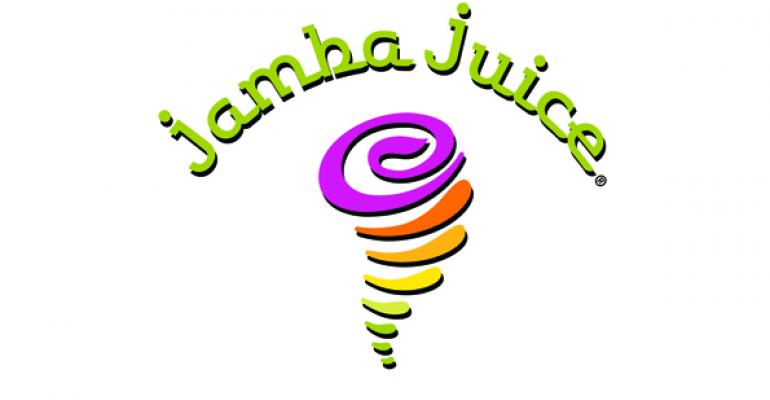Jamba Juice’s expanded fresh-juice platform is proving particularly fruitful for the smoothie chain, which posted steady gains for its July 2-ended second quarter this week despite a choppy economic environment that company officials see as the “new normal.”
James White, chair, president and chief executive of the smoothie chain’s parent Jamba Inc., said Monday that the fresh-juice platform, which has been added to 23 remodeled units, has increased sales between 3 percent and 4 percent with minimal marketing. At those units, fresh-juice sales now account for about 12 percent of the mix, he said.
RELATED
• Jamba narrows losses in 1Q
• Jamba looks to fresh juice to boost sales
• More menu news at NRN.com
While Emeryville, Calif.-based Jamba Juice has long offered juice, its new platform expands offerings to include freshly squeezed drinks and handcrafted blends incorporating whole foods such as beets, kale, carrots, cucumbers, apples and ginger.
The move is part of an ongoing effort by Jamba to recreate the smoothie concept as a more on-trend, healthful lifestyle brand. In recent weeks, for example, the chain has added several new trendy smoothie boost offerings such as Quaker Whole Grains — a hearty scoop of finely ground oatmeal that can be added to smoothies — along with Greek yogurt and chia seeds.
Last month the chain introduced a seasonal Kona Berry Blast smoothie featuring coffee fruit, the part of the coffee plant that surrounds the bean, which offers natural energy and antioxidants. Jamba Juice also added a Kona Berry Blast Bowl featuring the “Hawaiian superfruit” juice in a bowl with soy milk, bananas, strawberries, blueberries and granola.
The fresh juices and whole-food additions offer the chain an opportunity to differentiate in an increasingly competitive market, said White.
“Everybody has a smoothie these days,” he said. “There is a significant consumer move to more fruits and vegetables, and more whole foods in their diets, and juice is one of the easier ways to deliver higher nutrition that we think consumers are now rushing to find.”
Consumers who “juice,” or use juice beverages to replace meals, are more habitual users, he noted. “It will take away the seasonality of our business as we scale.”
Ramping up international growth
White said the company plans to accelerate the pace of remodels, with the expanded juice platform, next year. By the end of 2013, the company expects 50 units within the 829-unit Jamba Juice chain to be re-imaged, but White didn’t identify a number for 2014.
“We want to make sure we get it right,” he told analysts after the second-quarter report. “We’re very diligently working through the offering, the store environment and, importantly, the supply chain. And you’ll see us, as we move to 2014, lay out a game plan to accelerate the rollout beyond the 50 locations or so contemplated in the short run.”
In addition, Jamba will continue to speed up growth of the self-service JambaGo concept, which currently has about 600 locations and will reach 1,500 before the end of the year, White said. He added that the company is likely to unveil more detail about the performance of the JambaGo locations in the third quarter.
The company is also moving forward with its second limited-menu format, called Smoothie Station, which is a mini Jamba Juice that can be dropped into a 100- to 200-square-foot location. The first one debuted at Brooklyn College earlier this year.
White hinted that the Smoothie Station concept could be brought to another restaurant chain in a co-branding arrangement. “You’ll see us become a potential solution to other concepts,” he said. “We could solve a daypart issue.”
The chain is also aggressively pursuing international growth with a goal of reaching 1,000 international units over the next decade, White said. With 42 international locations open, the company has agreements for another 400 in countries like Mexico, Canada, the Philippines and South Korea, and expects to add new markets before the end of the year, he said.
Meanwhile, in the U.S., White said Jamba is well-positioned to weather what he described as the “new normal environment,” one in which the consumer continues to be challenged.
“I think we’re moving to a new place, just in terms of the operating environment that we’re all going to compete in,” he said. “The environment just continues to be a little bit choppy. And we actually believe that’s going to be the environment we’re going to be playing in for the foreseeable future.”
Bad weather was a factor hindering second quarter results, he noted. Excluding the negative impact of bad weather in certain regions, Jamba would have seen same-store sales climb 3.2 percent for both company and franchise stores, compared with the 1.7-percent systemwide increase the company recorded for the quarter, including a 2.2-percent increase for company-owned units that included a 1.6-percent bump in traffic. At franchise locations, same-store sales rose 1.2 percent.
For the year, Jamba is projecting a same-store sales increase of between 4 percent and 6 percent.
Contact Lisa Jennings at [email protected].
Follow her on Twitter: @livetodineout




